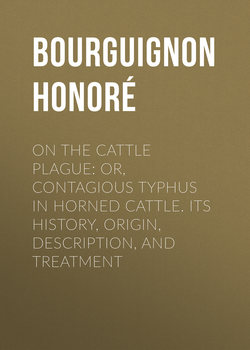Читать книгу On the cattle plague: or, Contagious typhus in horned cattle. Its history, origin, description, and treatment - Bourguignon Honoré - Страница 2
PREFACE
ОглавлениеNations, during the successive phases of their evolution on the globe, in which they advance from a state of infancy and barbarism to one of virility and civilization, from civilization to decadence or senility; and from decadence to their final extinction, are liable to numberless calamities.
These calamities are produced by moral causes, and are then called social Revolutions; and in other instances from physical causes, and then they are termed Cataclysms, Epidemics, or Epizootics.
In these crises, the initiative and devotion of individuals, the public administration, and the application of knowledge acquired in the Arts and Sciences, afford collectively an infallible criterion for ascertaining the position which a nation occupies in the scale of civilization, and the value of its religious, social, and political institutions.
Calamities always leave behind them disasters and victims, but they bequeath also a precious legacy. Nations which are called upon for fresh and progressive efforts, find in the experience they have gained a new source of strength and means of future greatness. I am convinced that this will be the case with England; though, helpless for the moment, and unable to stay the Cattle Plague which now ravages her entire extent, she will in future be found better prepared to resist the inroads of such a direful enemy.
No branch of human knowledge has been more rudely tested during the present epizootic than medical science. Many persons have been astounded at its helplessness; but if they had reflected at what a distance medicine has to follow in the wake of the exact sciences by which it is furnished with instruments for prosecuting its researches, – that organic chemistry progresses but slowly, – that the Cattle Plague was entirely unknown to the present generation of medical men in England, – and that the means for its scientific and practical study have been therefore wholly wanting, they would have been less surprised to find that it is as difficult to cure the Cattle Plague as it, is to cure phthisis, cancer, hydrophobia, and the cholera, against which medicine but too often is of little avail.
In times of great national calamity it behoves every one to contribute in proportion to his talents, fortune, or abilities, to alleviate the effects of the common misfortune. The poor man's mite, and the honest intention of the most insignificant, when added to the budget of common efforts, have their relative value; and it is for these reasons that I have published the following monograph on the Cattle Plague.
If it assists in any way to the extinction of the present epizootic, or if it serve to point out the necessity of combining the study of comparative pathology with that of medicine, I shall feel that I have contributed something which may favour my claim to be enrolled among the citizens of England.
This book, as may easily be seen, was originally written in my native language. A few kind and obliging friends – more particularly Mr. Taylor Sinnett, Drs. Clapton and Gervis, of St. Thomas's Hospital, and Mr. Berridge, of the British Museum – have rendered me the greatest assistance in the translation. Without the guidance of such competent auxiliaries I could not have performed my arduous task.
I therefore beg to return to those gentlemen, and to all those who have assisted me on this occasion, my sincerest and most grateful thanks.
H. B.
